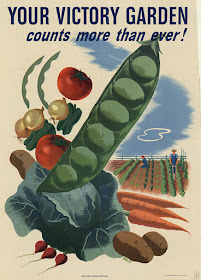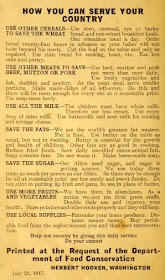 |
| WWII Poster |
In WWI and WWII, conservation of food was important to the war effort in the U.S.A. and around the world. Citizens were encouraged to be mindful of what they were eating, to buy local foods, and to grow and preserve their own food when possible. Women's magazines often featured recipes for dishes without wheat, meat or eggs.
 |
| WWI Poster (Courtesy of Library of Congress) |
Food rationing occurred in some countries during WWI, but did not occur in the USA until WWII. Food and other necessary items were in short supply, and families were issued stamps or coupons to redeem for a limited quantity of foods such as meats, cheese, butter, shortenings and canned goods. Sugar, coffee and gasoline were also rationed. This 1943 photograph from the United State Office of War Information is captioned as follows: "Preparation for point rationing. An eager school boy gets his first experience in using war ration book two. With many parents engaged in war work, children are being taught the facts of point rationing for helping out in family marketing."
 |
| Preparation For Point Rationing (1943)- Photo by Alfred T. Palmer (Courtesy of Library of Congress) |
The government encouraged the planting of War Gardens or Victory Gardens (the more common term in WWII), which were fruit and vegetable gardens located at homes and in public parks in the U.S., U.K., Canada, Australia and Germany. They helped to supplement the food supply, and also provided a morale boost to citizens who felt empowered by growing their own food. These fresh foods provided much needed nutrition, as well as variety, and people were encouraged to can and preserve their harvests.
 |
| WWII Poster (Courtesy of Wikimedia Commons) |
After work, Mr. and Mrs.Smith Find Time to Work in Their Victory Garden Behind Their House, Childersburg, Alabama (1942)
 |
| Photo by John Collier (Courtesy of Library of Congress) |
The following illustrations and photographs were produced during WWI and WWII, and they provide an interesting look at life during those eras. By encouraging moderation in diet, and emphasizing fresh, locally-grown foods, the information they provide is still relevant today.
 |
| Magazine Advertisement (1917) |
 |
| WWI Poster (Courtesy of Library of Congress) |
 |
| WWI Poster (Courtesy of Library of Congress) |
 |
| WWI Poster (Courtesy of Library of Congress) | |
 |
| WWI Poster (Courtesy of Library of Congress) |
 |
| WWI Poster (Courtesy of Library of Congress) |
 |
| WWI Poster (Courtesy of Library of Congress) |
 |
| WWI Poster by Charles Dana Gibson (Courtesy of Library of Congress) |
 |
| WWI Poster (Courtesy of Library of Congress) |
 |
| WWI Poster- Canada Food Board (Courtesy of Library of Congress) |
 |
| Dolly Dingle Paper Dolls by Grace Drayton (1918) |
 |
| Some Victory Gardeners Showing Their Fine Vegetables. 1942 or 1943 (Courtesy of Library of Congress) |
 |
| WWII Poster by Peter Fraser (Courtesy of The National Archives-United Kingdom) |
Children With Radishes Grown in the Fairlawn Avenue Victory Gardens
Washington D.C. (May 1943)
 |
| Photo by Joseph Anthony Home (Courtesy of Library of Congress) |
 |
| WWII Poster (Courtesy of Library of Congress) |





















No comments:
Post a Comment